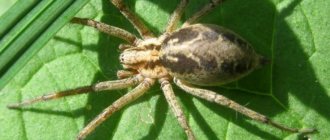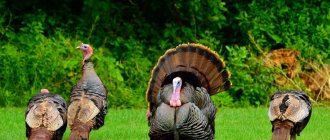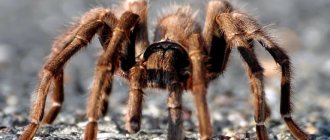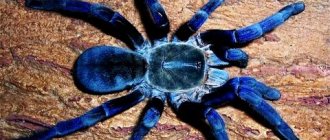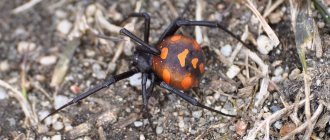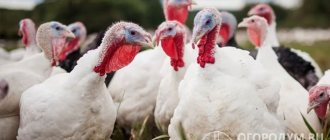The Goliath tarantula, scientific name Theraphosa blondi, is a spider belonging to the family Theraphosidae. This spider is the largest in the world, but in terms of paw span it is still inferior to the Heteropoda maxima spider from the family Sparassidae.
The name of the spider comes from an 18th century copper engraving that depicts a spider eating a hummingbird. Due to its size, the spider can hunt small birds, but in the wild this happens quite rarely.
In northeastern South America, goliath spiders are part of the diet of some peoples.
Goliath spider, top view
Appearance
The Goliath tarantula is an impressively sized spider. The body size reaches 12 cm, the leg span reaches up to 30 cm. Female spiders are larger than males. Males have a total size of up to 20 cm. Spiders have significant weight, some specimens reach a weight of 175 grams.
Body color varies from light brown to dark brown, and from reddish to black.
There may be darker or lighter lines on the legs that differ from the body color. Theraphosa blondi has eight small eyes at the front of its head and eight legs. Near the mouth there are two chelicerae and two pedipalps.
The chelicerae have venomous fangs, and the pedipalps are used to explore the environment and mate.
The spider's fangs range in size from 1.9 to 3.8 cm, they are hollow and connected to the spider's venom glands.
The entire body, including the legs, like most spiders, is covered with hairs. They are used as antennas to receive any vibrations and study the surrounding world, as well as as a means of protection.
Distribution map of Theraphosa blondi
Lifestyle
The Goliath tarantula leads a solitary and nocturnal lifestyle. It is a terrestrial spider, since due to its large weight it does not climb trees.
On this topic, you may be interested in: Types of scorpions, what they are, which are the most dangerous
Despite the fact that the spider has eight eyes, it has poor vision, no ears and does not perceive smells. Its olfactory organs are its hairs, which cover its entire body. Thanks to vibrations from the hairs, he manages to successfully hunt and avoid danger. Thanks to them, he receives information about the size of prey nearby.
This species, unlike most spiders, can make hissing sounds when danger arises. This hissing can be heard at a distance of up to 15 meters.
In case of danger, the spider begins to hiss loudly, rub the hair on its body with its hind legs, throwing it into the air; if this does not help, it stands on its hind legs and shows its fangs.
Natural enemies
Theraphosa blondi, despite its inherent toxicity, has quite a few of them. Large predators are not particularly interested in the goliath, but he and his offspring often become the gastronomic target of the following hunters:
- centipedes, for example, Scolopendra gigantea (40 cm in length);
- scorpions from the genera Liocheles, Hemilychas, Isometrus, Lychas, Urodacus (partially) and Isometroides;
- large spiders of the genus Lycosidae;
- ants;
- aha toad, or Bufo marinus.
The latter, by the way, has adapted to climb into holes where females and children are located in order to methodically devour newborns.
Goliath tarantulas also die under the hooves of heavy collared peccaries.
Goliath Spider Venom
Despite the fact that the spider has large fangs that easily bite through human skin, its venom is not dangerous to humans if there are no allergic reactions. The effect of the poison on humans is similar to that of a bee or wasp. A spider can bite a person only in self-defense, and in most cases the bite will be dry, without poison.
Spider hairs have an irritating effect; if they come into contact with the skin, they cause an itching effect; if they get into the respiratory system or mucous membrane, they can cause an allergic and irritating reaction.
If a spider releases venom during a bite, the following symptoms may appear: nausea, pain, redness and swelling may appear at the site of the bite.
All symptoms disappear within a few days. No fatalities from a spider bite of this species have been recorded.
Goliath spider eats a mouse
Colombian purple tarantula
These arthropods are also often found as eight-legged friends. However, the character of these tarantula spiders is not at all domestic - they are quite aggressive. Despite this, many still choose this “cute” furry spider, and besides, its bite is absolutely not dangerous for humans.
The Colombian violet tarantula looks out for its potential prey from a secluded place and when it is discovered, it immediately runs out of the shelter and, having overtaken the prey, pierces its body with its powerful chelicerae.
Characteristic:
- the span of the legs reaches 23 cm;
- range: Panama, Ecuador, Colombia, Peru and Venezuela, where it lives in tropical rainforests;
- the diet includes insects, small spiders, frogs, fish, small rodents and small birds;
- The lifespan of a female is 15 years, a male is no more than 3 years.
Food and hunting
Goliath spiders practice secretive hunting. He sits inside his hole and, thanks to his hairs, detects any movements around him.
At the right moment, he suddenly jumps out of the hole and attacks his prey. Like all spiders, he injects his poison into it, which kills the victim and dissolves its insides, and then sucks them out of it.
On this topic, you may be interested in: How do spiders differ from insects?
The spider's diet consists of various insects, other arthropods, worms and small vertebrates.
It can easily catch and eat amphibians, rodents, lizards and some snakes. Sometimes it can catch a bird, but this happens quite rarely.
Lifespan and reproduction
The female spider has a lifespan of 10 to 20 years, reaching sexual maturity between 3 and 6 years of age. Males live less, no more than six years. They die naturally when they reach sexual maturity and mate.
Male spiders have what looks like a hook on the front of their first forelegs, which they use to hold and block the female's fangs during mating, this allows them to survive after mating without being eaten by the female.
A few days after mating, the female lays 50 to 200 eggs. In some cases, females can retain a male's sperm for up to 15 months, so they can lay several clutches of fertilized eggs. This happens if the female has already shed before mating, otherwise, at the moment of molting with the old exoskeleton, she also loses the male’s sperm supply.
The spider eggs are wrapped in a silk cocoon and laid in a hole; the cocoon is the size of a tennis ball; on top of the cocoon, the male sheds his hairs, which protect him from various pests.
The female protects the eggs until they hatch, which occurs after 4 months. At this time, she does not hunt and is aggressive. The hatched spiders are about 2 cm in size and do not leave the burrow until their first moult. After emerging from the burrow, young spiders become food for birds, bats and large insects. In the wild, out of two hundred hatched spiders, only a few survive.
On this topic, you may be interested in: Sydney funnel web spider, or Atrax robustus
Nevertheless, the spider is not endangered and is not protected by various states; its population in the world is considered quite stable.
Today, the spider is threatened by deforestation, capture from the wild for captivity, and capture for sale for culinary purposes, as their meat has been part of the culinary traditions of some peoples for centuries.
Video
Spiders are long-lived
Common house spider
The lifespan of house spiders is usually 8-12 months. They die after breeding, from lack of food, by human hands.
Only 10 species of spiders out of 42 thousand can live in houses and apartments. The most common species is Tegenaria domestica. This is a small (12 mm in diameter including legs) spider of a yellowish-brown color.
It weaves a flat triangular web, not just one, but several at once, and connects them with threads for movement. Under favorable conditions it can live up to 5 years. It is harmless and non-aggressive, but can bite a person if pressed down.
In private homes, a cross is often found. It is distinguished by a white cross on the back and a patterned circular web. The life span of the cross is short: males can live from 4 to 6 months, females - 2-3 months.
Sometimes you come across a haymaker (“long-legged”) - a small oblong body from 2 to 10 mm long on long, fragile legs. The web is woven chaotically and has no clear shape. This spider lives at home for about 2 years.
Exotic animals
Large poisonous spiders have long gained popularity as exotic animals suitable for home keeping. Even at home, it is quite possible to create favorable conditions for their existence and reproduction.
Tarantulas or tarantulas are usually kept in the apartment. There are many varieties, differing in color, behavior, hairiness and body structure. They can live for a long time, so some people become attached to such pets in the same way as to cats or dogs.
Popular types of tarantulas:
- curly-haired (Brachypelma Albopilosum) – black, covered with pinkish hairs. The most unpretentious look. The bite is noticeable, painful, but not dangerous to human health. Males live 3 to 4 years, females can live more than 20 years;
- woody (Avicularia Versicolor) – covering of young growth is blue with white hairs. The adult individual is colored in blue, red, green shades with a metallic tint. One of its features is that it moves very quickly. The poison is safe for humans. Males live from 1.5 to 2 years, females can live up to 8 years;
- The Horse Spider (Lasiodora Parahybana) is one of the largest tarantulas. The color is gray with black or brown. Actively digs the substrate and easily chews through fragile parts of the terrarium. Females can live 15-25 years, males - from 2 to 3 years.
For terrarium maintenance, 5 types are usually used:
- Apulian is one of the largest (body length up to 7 cm long). Females are red in color and their lifespan ranges from 3 to 4 years. Males are light gray and can live no more than 2-3 years.
- South Russian (also called “mizgir”). Body length 3.5 cm. Color varies from brownish to brown. Can live up to 5 years.
- Spanish. The male is dark gray. Lives for about 2 years, participates in fertilization only once in its life. Females are red in color with a striped belly. They can live more than 5 years.
- Mexican. Fluffy, abdomen length up to 14 cm, black-gray color, the folds of the legs are red (the second name of the spider is “red-knee tarantula”). They are distinguished by their slow growth and maturation: males are capable of fertilization at the age of 4 years, rarely live longer than 10, females can give birth to offspring at 6-7 years, and live up to 20-30 years. In captivity, maturation occurs faster, which reduces life expectancy.
- Brazilian black. The abdomen is 7 cm long, the body is black and shiny. Relatively calm view. They mature at the age of 6-7 years, females can live 20 years. Males rarely reach 10.
To increase the lifespan of a spider, it needs to be fed less (the rule does not apply to juveniles). The abundance of food provokes growth and change of the exoskeleton.
The more often this animal sheds, the shorter it will live. Tarantulas can refuse to eat for about 2 years for no apparent reason. They are considered the longest-livers among their relatives.
It’s not worth doing such experiments on them at home, but if he doesn’t want to eat for 1-2 weeks, then there’s no need to persistently feed him. Such a hunger strike will not affect the quality of life. This usually happens before molting.
Mice, lizards and frogs should not be given. This means an increased risk of injury to the spider and an unpleasant odor in the house. The best option is marble cockroaches.
At cool temperatures, the metabolic processes of the spider's body slow down, which also helps to increase its lifespan. In the wild, hibernating spiders will live longer than indoor spiders.
To prolong the life of a male spider during the mating process, it is important to monitor the behavior of the female. It is necessary to intervene in time with the help of special forceps or a shield, since spiders usually eat their partner after fertilization. At the end of the process, the couple is separated
Once the process is complete, the couple is separated.
Keeping a spider in captivity
The spider can be kept in captivity, but it is necessary to provide it with suitable conditions. This makes the spider quite difficult to keep, so they do not live long in captivity. Also, the species can be quite aggressive, which will cause problems for an inexperienced owner.
You need a spacious spider bed with a large amount of soil (coconut substrate) to build a burrow, or install a shelter, such as a large coconut shell.
It is important to constantly maintain high humidity from 80 to 95%, the required temperature is from 25 to 30°C.
You can feed the spider with large insects and small rodents. Young spiders can be fed several times a week; adult spiders need to be fed once a week. To avoid mold, there must be mandatory ventilation in the spider plant.
The danger for humans when keeping this species is represented by its hairs, which sooner or later will cause various allergic and irritating reactions in the owner, since they will enter the room through the ventilation of the spider, it is necessary to carefully consider the choice of place to place the spider.
Goliath spider hairs
